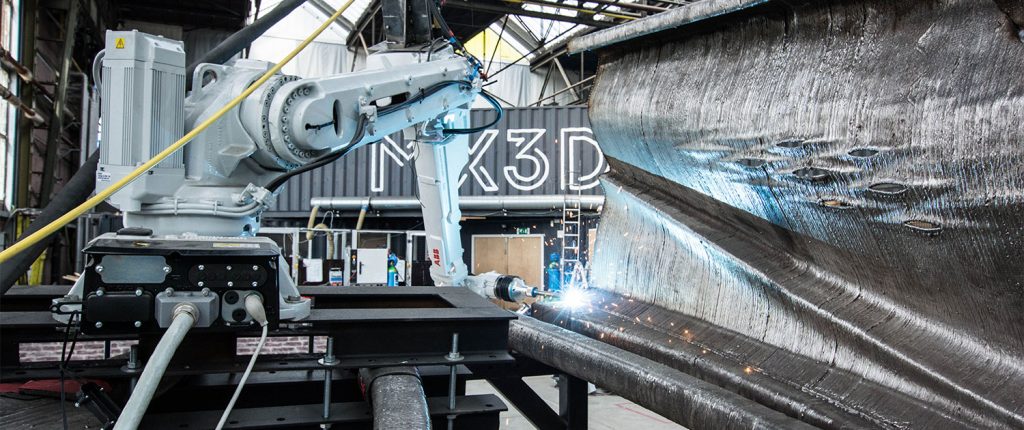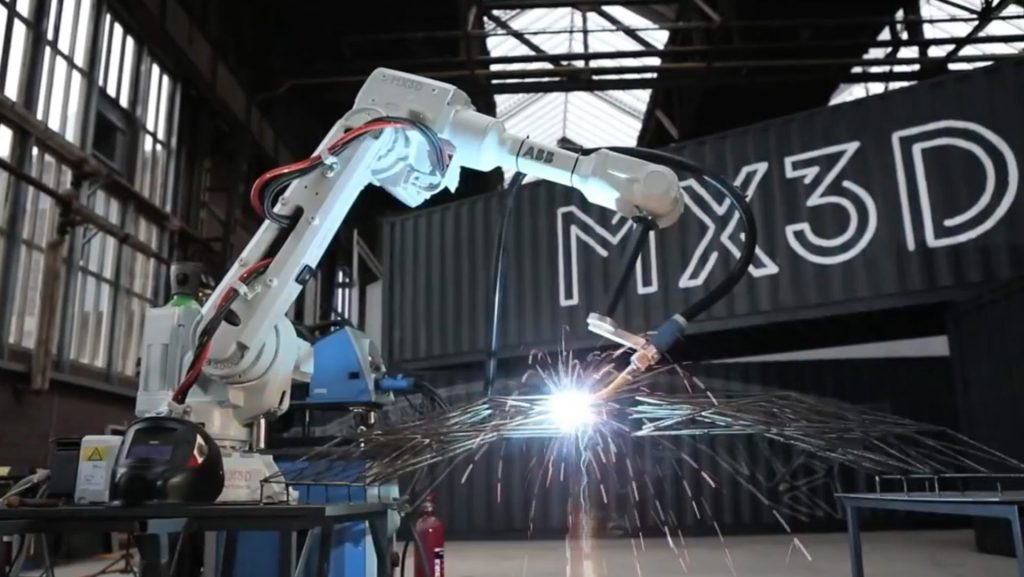Later in 2018, the Oudezijds Achterburgwal canal in Amsterdam is set to be graced with a 12 meter long 3D printed steel bridge, made by Robotic Additive Manufacturing (RAM) technology developer MX3D.
Constructed using ABB robotic arms and WAAM technology, after installation the company has confirmed that a second, digital, bridge construction project will begin.
MX3D is collaborating with the Cambridge Centre for Smart Infrastructure and Construction (CSIC), Imperial College London, and The Alan Turing Institute in the UK to install sensors on the 3D printed bridge.
Data gathered by these sensors will be used to help build a Digital Twin of the structure, making it a living, and atmospherically observant part of the city.
Video courtesy The Times, Neil Bowdler and MX3D
An engineering first
An ambitious project, MX3D’s founders envisioned a bridge to be 3D printed in-situ. The robotic arms were initially intended to move with the structure, and 3D print across a support-free space.
Realizing the challenges of this concept through trial and error, MX3D has since opted to 3D print the bridge in segments and assemble them afterwards across the canal. Nevertheless, MX3D’s effort remains a world first in engineering.
Professor Mark Girolami is leading sensor and Digital Twin development for MX3D at Imperial College London. He calls the ambitious 3D printed bridge project “a powerful embodiment of what data-centric engineering can deliver as a discipline.”
Girolami and the team at Imperial’s Steel Structures group, are in charge of developing the initial Digital Twin model. So far, the team has been testing sample structures to understand how the bridge might respond to different pressures.

A “living” bridge
The CSIC is a facility of the University of Cambridge funded by the Engineering and Physical Sciences Research Council (EPSRC) and Innovate UK. Working with Imperial’s Steel Structures Group and the Turing Institute, the CSIC is developing the bridge’s sensory nervous system.
When completed, the bridge will be capable of supporting pedestrians and cyclists travelling through central Amsterdam. Sensors will be able to provide valuable data about this people traffic and more. CSIC co-investigator Dr. Mohammed Elshafie describes the key features of the system as follows: “The sensors collect data on structural measurements including strain, displacement and vibration and measure environmental factors such as air quality and temperature,”
“This enables engineers to monitor the ‘health’ of the bridge in real time and observe and record how it changes throughout its lifespan.”
Overall, he says,
“The sensor network provides a ‘nervous system’ for the bridge and creates a living laboratory for the researchers and engineers.”

The next generation of bridges
Autodesk is providing the cloud-based software to collect data generated at the bridge, and The Amsterdam Institute for Advanced Metropolitan Solutions will be exploring ways to connect this data to other streams in the city.
Girolami at Imperial concludes, “[this] multidisciplinary approach to capturing the bridge’s data will also mark a step-change in the way bridges are designed, constructed, and managed, generating valuable insights for the next generation of bridges and other major public structures.”
Spanish infrastructural group ACCIONA and the Institute for Advanced Architecture of Catalonia (IAAC) in Barcelona have also previously demonstrated efforts at a world first 3D printed bridge.
Keep up to date with the latest developments in 3D printing. Subscribe to the 3D Printing Industry newsletter, follow us on Twitter and like us on Facebook.
Vote for the 3D printing application of the year and more in the 2018 3D Printing Industry Awards.
Our 3D Printing Jobs service is now live. Post a job or advance your career in 3D printing now.
Featured image shows concept visualization of data capture from the 3D printed bridge. Image via MX3D


